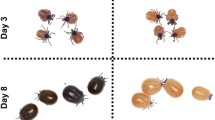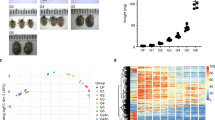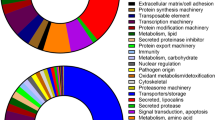Abstract
As it feeds upon cattle, Rhipicephalus (Boophilus) microplus is capable of transmitting a number of pathogenic organisms, including the apicomplexan hemoparasite Babesia bovis, a causative agent of bovine babesiosis. The R. microplus female gut transcriptome was studied for two cohorts: adult females feeding on a bovine host infected with B. bovis and adult females feeding on an uninfected bovine. RNA was purified and used to generate a subtracted cDNA library from B. bovis-infected female gut, and 4,077 expressed sequence tags (ESTs) were sequenced. Gene expression was also measured by a microarray designed from the publicly available R. microplus gene index: BmiGI Version 2. We compared gene expression in the tick gut from females feeding upon an uninfected bovine to gene expression in tick gut from females feeding upon a splenectomized bovine infected with B. bovis. Thirty-three ESTs represented on the microarray were expressed at a higher level in female gut samples from the ticks feeding upon a B. bovis-infected calf compared to expression levels in female gut samples from ticks feeding on an uninfected calf. Forty-three transcripts were expressed at a lower level in the ticks feeding upon B. bovis-infected female guts compared with expression in female gut samples from ticks feeding on the uninfected calf. These array data were used as initial characterization of gene expression associated with the infection of R. microplus by B. bovis.

Similar content being viewed by others
References
Altschul SF, Gish W, Miller W, Myers EW, Lipman DJ (1990) Basic local alignment search tool. J Mol Biol 215:403–410
Anderson JM, Sonenshine DE, Valenzuela JG (2008) Exploring the mialome of ticks: an annotated catalogue of midgut transcripts from the hard tick, Dermacentor variabilis (Acari: Ixodidae). BMC Genomics 9:552
Antunes S, Galindo RC, Almazan C, Rudenko N, Golovchenko M, Grubhoffer L, Shkap V, do Rosario V, de la Fuente J, Domingos A (2012) Functional genomic studies of Rhipicephalus (Boophilus) annulatus ticks in response to infection with the cattle protozoan parasite, Babesia bigemina. Int J Parasitol 42:187–195
Ashburner M, Ball CA, Blake JA, Botstein D, Butler H, Cherry JM, Davis AP, Dolinski K, Eppig JT, Harris MA, Hill DP, Issel-Traver L, Kasarskis A, Lewis S, Matese JC, Richardson JE, Ringwald M, Rubin GM, Sherlock G (2000) Gene ontology: tool for the unification of biology. The Gene Ontology consortium. Nat Genet 25:25–29
Babin PJ, Bogerd J, Kooiman FP, Van Marrewijk WJ, Van der Horst DJ (1999) Apolipophorin II/I, apolipoprotein B, vitellogenin, and microsomal triglyceride transfer protein genes are derived from a common ancestor. J Mol Evol 49:150–160
Bairoch A, Apweiler R, Wu CH, Barker WC, Boeckman B, Ferro S, Gasteiger E, Huang H, Lopez R, Magrane M, Martin MJ, Natale DA, O’Donovan C, Redaschi N, Yeh LSL (2005) The universal protein resource (UniProt). Nucleic Acids Res 33:D154–D159
Baker ME (1988a) Invertebrate vitellogenin is homologous to human von Willebrand factor. Biochem J 256:1059–1061
Baker ME (1988b) Is vitellogenin an ancestor of apolipoprotein B-100 of human low-density lipoprotein and human lipoprotein lipase? Biochem J 255:1057–1060
Bock R, Jackson L, de Vos A, Jorgensen W (2004) Babesiosis of cattle. Parasitol 129:S247–S269
Brown WC, Norimine J, Goff WL, Suarez CE, McElwain TF (2006) Prospects for recombinant vaccines against Babesia bovis and related parasites. Parasite Immunol 28:315–327
de la Fuente J, Almazan C, Blas-Machado U, Naranjo V, Mangold AJ, Blouin EF, Gortazar C, Kocan KK (2006) The tick protective antigen, 4D8, is a conserved protein involved in modulation of tick blood ingestion and reproduction. Vaccine 24:4082–4095
Dong B, Liu F, Gao H, Wang B, Xiang J (2009) cDNA cloning and gene expression pattern following bacterial challenge of peroxinectin in Chinese shrimp Fenneropenaeus chinensis. Mol Biol Rep 36:2333–2339
Donohue KV, Khalil SMS, Sonenshine DE, Roe RM (2009) Heme-binding storage proteins in the Chelicerata. J Insect Physiol 55:287–296
Dreher-Lesnick SM, Mulenga A, Simser JA, Azad AF (2006) Differential expression of two glutathione S-transferases identified from the American dog tick, Dermacentor variabilis. Insect Mol Biol 15:445–453
Farias LP, Tararam CA, Miyasato PA, Nishiyama MY Jr, Oliveira KC, Kawano T, Verjovski-Almeida S, Cezar de Cerqueira Leite L (2011) Screening the Schistosoma mansoni transcriptome for genes differentially expressed in the schistosomulum stage in search for vaccine candidates. Parasitol Res 108:123–135
Fogaça AC, Lorenzini DM, Kaku LM, Esteves E, Bulet P, Daffre S (2004) Cysteine-rich antimicrobial peptides of the cattle tick Boophilus microplus: isolation, structural characterization and tissue expression profile. Develop Comp Immunol 28:191–200
Gentleman RC, Carey VJ, Bates DM, Bolstad B, Dettling M, Dudoit S, Ellis B, Gautier L, Ge YC, Gentry J, Hornik K, Hothorn T, Huber W, Iacus S, Irizarry R, Leisch F, Li C, Maechler M, Rossini AJ, Sawitzki G, Smith C, Smyth G, Tierney L, Yang JYH, Zhang JH (2004) Bioconductor: open software development for computational biology and bioinformatics. Genome Biol 5:R80
Gohil S, Kats LM, Sturm A, Cooke BM (2010) Recent insights into alteration of red blood cells by Babesia bovis: moovin’ forward. Trends Parasitol 26:591–599
Gudderra NP, Neese PA, Sonenshine DE, Apperson CS, Roe RM (2001) Developmental profile, isolation and biochemical characterization of a novel lipoglycoheme-carrier protein from the American dog tick, Dermacentor variabilis (Acari: Ixodidae) and observations on a similar protein in the soft tick, Ornithodoros parkeri (Acari: Argasidae). Insect Biochem Mol Biol 31:299–311
Guerrero FD, Miller RJ, Rousseau ME, Sunkara S, Quackenbush J, Lee Y, Nene V (2005) BmiGI: a database of cDNAs expressed in Boophilus microplus, the tropical/southern cattle tick. Insect Biochem Mol Biol 35:585–595
Han Q, Li G, Li J (2000) Chorion peroxidase-mediated NADH/O2 oxidoreduction cooperated by chorion malate dehydrogenase-catalyzed NADH production: a feasible pathway leading to H2O2 formation during chorion hardening in Aedes aegypti mosquitoes. Biochem Biophys Acta 5:162
Heekin AM, Guerrero FD, Bendele KG, Saldivar L, Scoles GA, Gondro C, Nene V, Djikeng A, Brayton KA (2012) Analysis of Babesia bovis infection-induced gene expression changes in larvae from the cattle tick, Rhipicephalus (Boophilus) microplus. Parasites Vectors 5:162
Huang DW, Sherman BT, Lempicki RA (2009a) Systematic and integrative analysis of large gene lists using DAVID Bioinformatics Resources. Nat Protoc 4:44–57
Huang DW, Sherman BT, Lempicki RA (2009b) Bioinformatics enrichment tools: paths toward the comprehensive functional analysis of large gene lists. Nucleic Acids Res 37:1–13
Huang X, Madan A (1999) CAP3: a DNA sequence assembly program. Genome Res 9:868–877
Irizarry RA, Bolstad BM, Collin F, Cope LM, Hobbs B, Speed TP (2003a) Summaries of Affymetrix GeneChip probe level data. Nucleic Acids Res 31:e15
Irizarry RA, Hobbs B, Collin F, Beazer-Barclay YD, Antonellis KJ, Scherf U, Speed TP (2003b) Exploration, normalization, and summaries of high density oligonucleotide array probe level data. Biostatistics 4:249–264
Jaworski DC, Zou Z, Bowen J, Wasala NB, Madden R, Wang Y, Kocan KM, Jiang H, Dillwith JW (2010) Pyrosequencing and characterization of immune response genes from the American dog tick, Dermacentor variabilis (L.). Insect Mol Biol 19:617–630
Kongsuwan K, Josh P, Zhu Y, Pearson R, Gough J, Colgrave ML (2010) Exploring the midgut proteome of partially fed female cattle tick (Rhipicephalus (Boophilus) microplus). J Insect Physiol 56:212–226
Lima CA, Torquato RJ, Sasaki SD, Justo GZ, Tanaka AS (2010) Biochemical characterization of a Kunitz type inhibitor similar to dendrotoxins produced by Rhipicephalus (Boophilus) microplus (Acari: Ixodidae) hemocytes. Vet Parasitol 167:279–287
Logullo C, Vaz IS Jr, Sorgine MHF, Paiva e Silva GO, Faria FS, Zingali BR, Lima MFR, Masuda H, Gonzales JC, Masuda A, Oliveira PL (1998) Isolation of an aspartic proteinase precursor from the egg of a hard tick, Boophilus microplus. Parasitol 116:525–532
Lowe TM, Eddy SR (1997) tRNAscan-SE: a program for improved detection of transfer RNA genes in genomic sequence. Nucleic Acids Res 25:955–964
Mercado-Curiel RF, Palmer GH, Guerrero FD, Brayton KA (2011) Temporal characterization of the organ-specific Rhipicephalus microplus transcriptional response to Anaplasma marginale infection. Int J Parasitol 41:851–860
Miyoshi T, Tsuji N, Islama KM, Kamioa T, Fujisaki K (2004) Cloning and molecular characterization of a cubilin-related serine proteinase from the hard tick Haemaphysalis longicornis. Insect Biochem Mol Biol 34:799–808
Mulder N, Apweiler R (2007) InterPro and InterProScan: tools for protein sequence classification and comparison. Methods Mol Biol 396:59–70
Mulenga A, Macaluso KR, Simser JA, Azad AF (2003) Dynamics of Rickettsia–tick interactions: identification and characterization of differentially expressed mRNAs in uninfected and infected Dermacentor variabilis. Insect Mol Biol 12:185–193
Nuttall PA, Trimnell AR, Kazimirova M, Labuda M (2006) Exposed and concealed antigens as vaccine targets for controlling ticks and tick-borne diseases. Parasite Immunol 28:155–163
Oldiges DP, Parizi LF, Zimmer KR, Lorenzini DM, Seixas A, Masuda A, de Silva Vaz Jr I (2012) A Rhipicephalus (Boophilus) microplus cathepsin with dual peptidase and antimicrobial activity. Int J Parasitol 42:635–645
Pereira LS, Oliveira PL, Barja-Fidalgo C, Daffre S (2001) Production of reactive oxygen species by hemocytes from the cattle tick Boophilus microplus. Exp Parasitol 99:66–72
Pichu S, Yalcin EB, Ribeiro JMC, King RS, Mather TN (2011) Molecular characterization of novel sulfotransferases from the tick Ixodes scapularis. BMC Biochem 12:32
Pohl PC, Sorgine MHF, Leall AT, Logullo C, Oliveira PL, da Silva Vaz Jr I, Masuda A (2008) An extraovarian aspartic protease accumulated in tick oocytes with vitellin-degradation activity. Comp Biochem Physiol Part B 151:392–399
R Development Core Team (2009) R: a language and environment for statistical computing. R Foundation for Statistical Computing, Vienna, Austria. Available at http://www.r-project.org/index.html
Rachinsky A, Guerrero FD, Scoles GA (2008) Proteomic profiling of Rhipicephalus (Boophilus) microplus gut responses to infection with Babesia bovis. Vet Parasitol 152:294–313
Rodriguez-Valle M, Lew-Tabor A, Gondro C, Moolhuijzen P, Vance M, Guerrero FD, Bellgard M, Jorgensen W (2010) Comparative microarray analysis of Rhipicephalus (Boophilus) microplus expression profiles of larvae pre-attachment and feeding adult female stages on Bos indicus and Bos taurus cattle. BMC Genomics 11:437
Rosa de Lima MF, Sanchez Ferreira CA, Joaquim de Freitas DR, Valenzuela JG, Masuda A (2002) Cloning and partial characterization of a Boophilus microplus (Acari: Ixodidae) glutathione S-transferase. Insect Biochem Mol Biol 32:747–754
Rudenko N, Golovchenko M, Edwards MJ, Grubhoffer L (2005) Differential expression of Ixodes ricinus tick genes induced by blood feeding or Borrelia burgdorferi infection. J Med Entomol 42:36–41
Saldivar L, Guerrero FD, Miller RJ, Bendele KG, Gondro C, Brayton KA (2008) Microarray analysis of acaricide-inducible gene expression in the southern cattle tick, Rhipicephalus (Boophilus) microplus. Insect Mol 17:597–606
Sambrook J, Fritsch EF, Maniatis T (1989) Molecular cloning: a laboratory manual. Cold Spring Harbor Laboratory Press, Cold Spring Harbor
Schmid R, Blaxter ML (2008) Annot8r: GO, EC and KEGG annotation of EST datasets. BMC Bioinforma 9:180
Schwarz A, Valdés JJ, Kotsyfakis M (2012) The role of cystatins in tick physiology and blood feeding. Ticks Tick Borne Dis 3:117–127
Seixas A, Oliveira P, Termignoni C, Logullo C, Masuda A, da Silva Vas Jr I (2012) Rhipicephalus (Boophilus) microplus embryo proteins as target for tick vaccine. Vet Immunol Immunopathol 148:149–156
Shelness GS, Ledford AS (2005) Evolution and mechanism of apolipoprotein B-containing lipoprotein assembly. Curr Opin Lipidol 16:325–332
Skern-Mauritzen S, Frost P, Dalvin S, Kvamme BO, Sommerset I, Nilsen F (2009) A trypsin-like protease with apparent dual function in early Lepeophtheirus salmonis (Krøyer) development. BMC Mol Biol 10:44
Storey JD (2002) A direct approach to false discovery rates. J R Stat Soc Ser B Stat Methodol 64:479–498
Suzek BE, Huang H, McGarvey P, Mazumder R, Wu CH (2007) UniRef: comprehensive and non-redundant UniProt reference clusters. Bioinformatics 23:1282–1288
Thompson DM, Khalil SMS, Jeffers LA, Ananthapadmanaban U, Sonenshine DE, Mitchell RD, Osgood CJ, Apperson CS, Roe RM (2005) In vivo role of 20-hydroxyecdysone in the regulation of the vitellogenin mRNA and egg development in the American dog tick, Dermacentor variabilis (Say). J Insect Physiol 51:1105–1116
Tsuji N, Miyoshi T, Battsetseg B, Matsuo T, Xuan X, Fujisaki K (2008) A cysteine protease is critical for Babesia spp. transmission in Haemaphysalis ticks. PLoS Pathog 4:e1000062
Tusher VG, Tibshirani R, Chu G (2001) Significance analysis of microarrays applied to the ionizing radiation response. Proc Natl Acad Sci 98:5116–5121
Urieli-Shoval S, Linke RP, Matzner Y (2000) Expression and function of serum amyloid A, a major acute-phase protein, in normal and disease states. Curr Opin Hematol 7:64–69
Wasmuth JD, Blaxter ML (2004) prot4EST: translating expressed sequence tags from neglected genomes. BMC Bioinforma 5:187
Willadsen P (2004) Anti-tick vaccines. Parasitology 129:S367–S387
Acknowledgments
AH participated in the bioinformatic analysis of the subtracted library and drafted the manuscript. FDG conceived the study, participated in the design, data collection, and analysis of the study and helped draft the manuscript. KGB participated in the data collection, data analysis, and designed the RT-PCR verification study. LS, SED, and CG participated in analysis of the microarray data; GAS participated in the overall study design and collection of tick materials. VN, SED, and AD participated in the study design and coordinated the sequencing phases. KAB participated in the study design and microarray experimental design. All authors read and approved the final manuscript. LS was supported by the National Research Initiative of the USDA CSREES grant #2005-35604-15440 (to KAB and FDG). This article reports the results of research only. Mention of trade names or commercial products in this publication is solely for the purpose of providing specific information and does not imply recommendation of endorsement by the USDA. The USDA is an equal opportunity provider and employer.
Author information
Authors and Affiliations
Corresponding author
Rights and permissions
About this article
Cite this article
Heekin, A.M., Guerrero, F.D., Bendele, K.G. et al. Gut transcriptome of replete adult female cattle ticks, Rhipicephalus (Boophilus) microplus, feeding upon a Babesia bovis-infected bovine host. Parasitol Res 112, 3075–3090 (2013). https://doi.org/10.1007/s00436-013-3482-4
Received:
Accepted:
Published:
Issue Date:
DOI: https://doi.org/10.1007/s00436-013-3482-4




